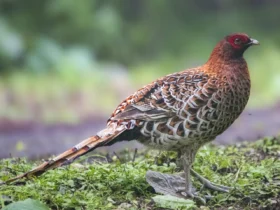Tanagers are a diverse and colorful group of birds belonging to the family Thraupidae. They are found primarily in the Americas, ranging from the southern regions of North America to the southernmost tip of South America. Here is some information about tanager species:
Physical Characteristics: Tanagers come in a wide range of sizes and colors. While some species are relatively plain, many are known for their vibrant plumage, featuring shades of red, orange, yellow, blue, and green. The bright colors of male tanagers are often more vivid than those of females. Tanagers have various bill shapes, reflecting their diverse feeding habits.
Habitat and Distribution: Tanagers are distributed across a wide range of habitats, including tropical rainforests, cloud forests, grasslands, scrublands, and mountainous regions. They are most abundant in Central and South America, where they can be found in various ecological niches.
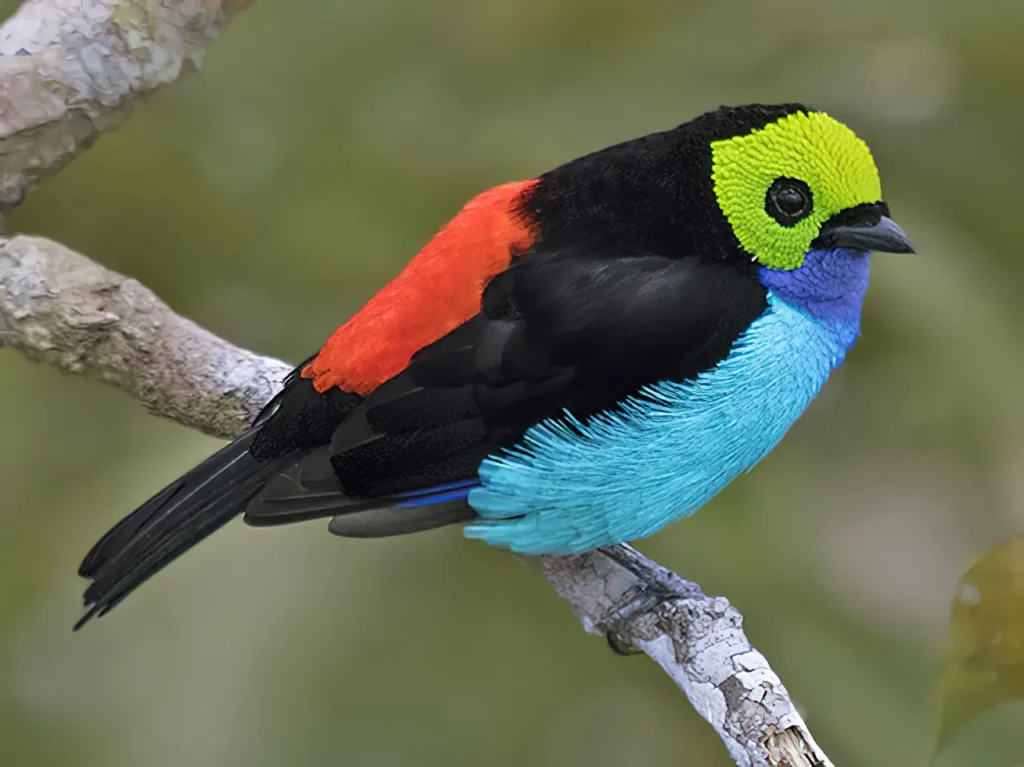
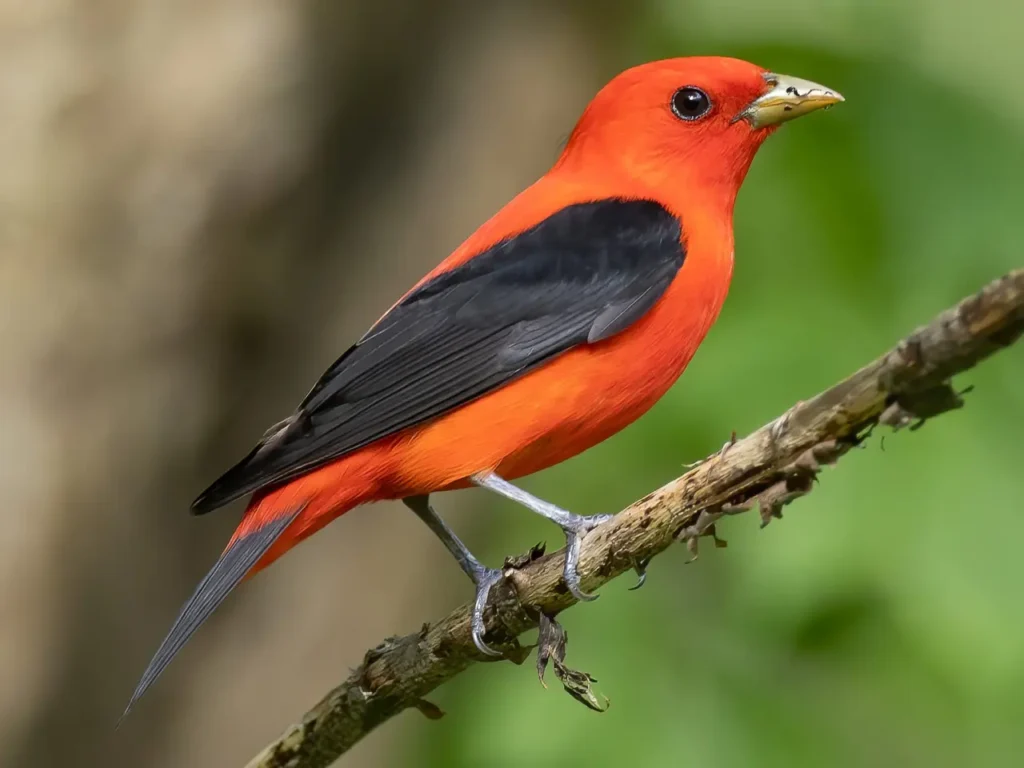
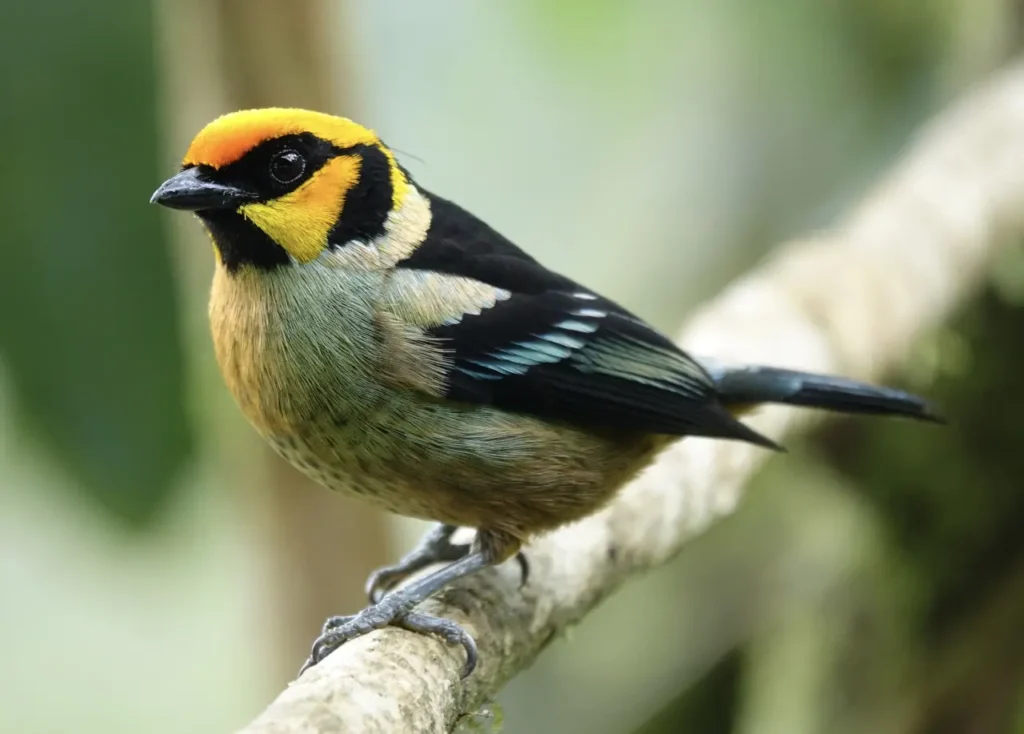
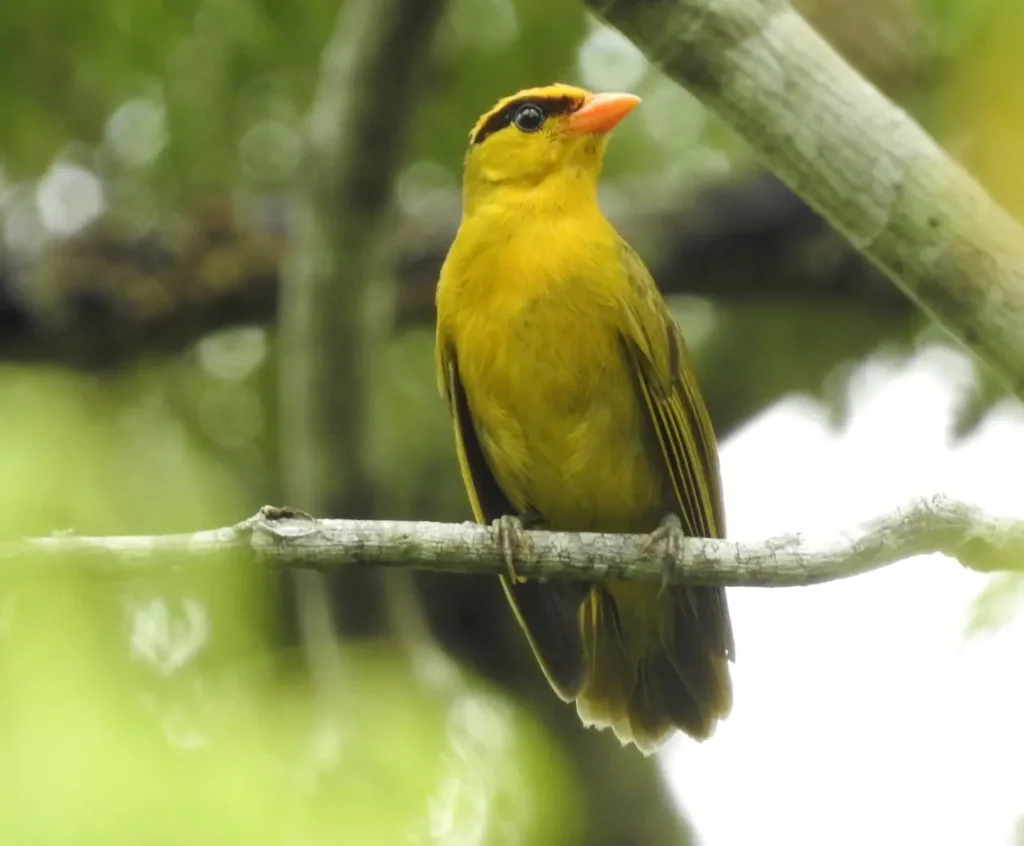
Diet: Tanagers have diverse diets, reflecting the availability of food in their respective habitats. Many species are primarily frugivorous, feeding on fruits and berries. Others consume nectar, insects, spiders, and small arthropods. Some tanagers are known to supplement their diet with flowers, seeds, and even small vertebrates.
Behavior: Tanagers are typically arboreal, spending much of their time in the trees and shrubs. They are often seen in small flocks, especially during the non-breeding season. During the breeding season, male tanagers may become more territorial and display vibrant colors to attract females.
Breeding and Nesting: Tanagers construct cup-shaped nests made of twigs, leaves, and other plant materials. The nests are usually well-hidden among foliage. Female tanagers lay a clutch of eggs, and both parents take turns incubating the eggs and caring for the chicks. Some species engage in cooperative breeding, where non-breeding individuals help raise the young.
Notable Species: The tanager family Thraupidae is vast, with over 400 recognized species. Some well-known tanager species include the Scarlet Tanager (Piranga olivacea) and Summer Tanager (Piranga rubra) in North America, the Blue-gray Tanager (Thraupis episcopus) and Palm Tanager (Thraupis palmarum) in Central and South America, and the Paradise Tanager (Tangara chilensis) and Flame-faced Tanager (Tangara parzudakii) found in South America.
Conservation: While many tanager species have stable populations, some are facing threats due to habitat loss, deforestation, and illegal pet trade. The destruction of tropical forests, where many tanagers reside, is a significant concern for their conservation. Efforts to protect their habitats, support sustainable forest management, and combat illegal trade are essential for their survival.
Tanager species are beloved by birdwatchers and naturalists for their captivating colors and diverse behaviors. They play crucial roles in their ecosystems as seed dispersers and pollinators for various plant species. As such, preserving their habitats and ensuring their protection is vital for maintaining the biodiversity of the Americas.
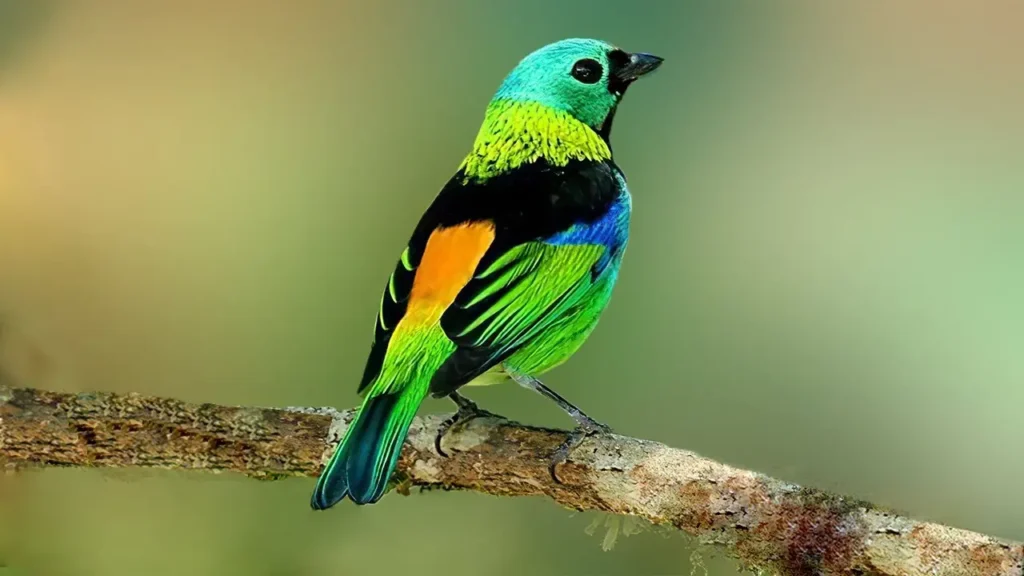
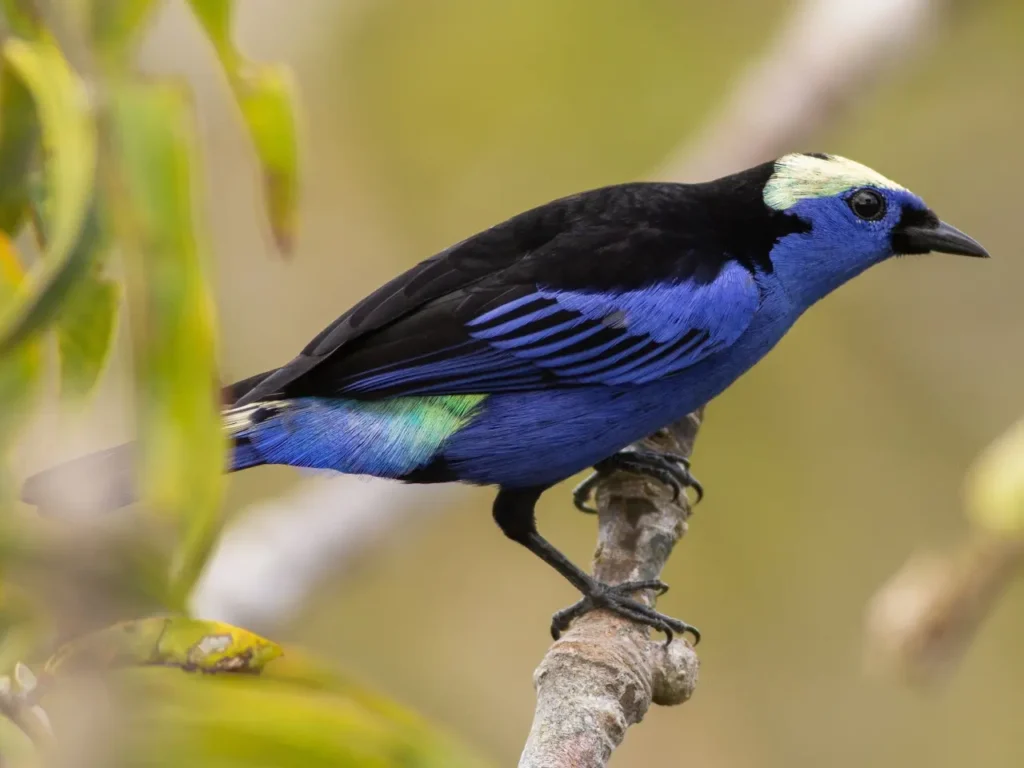
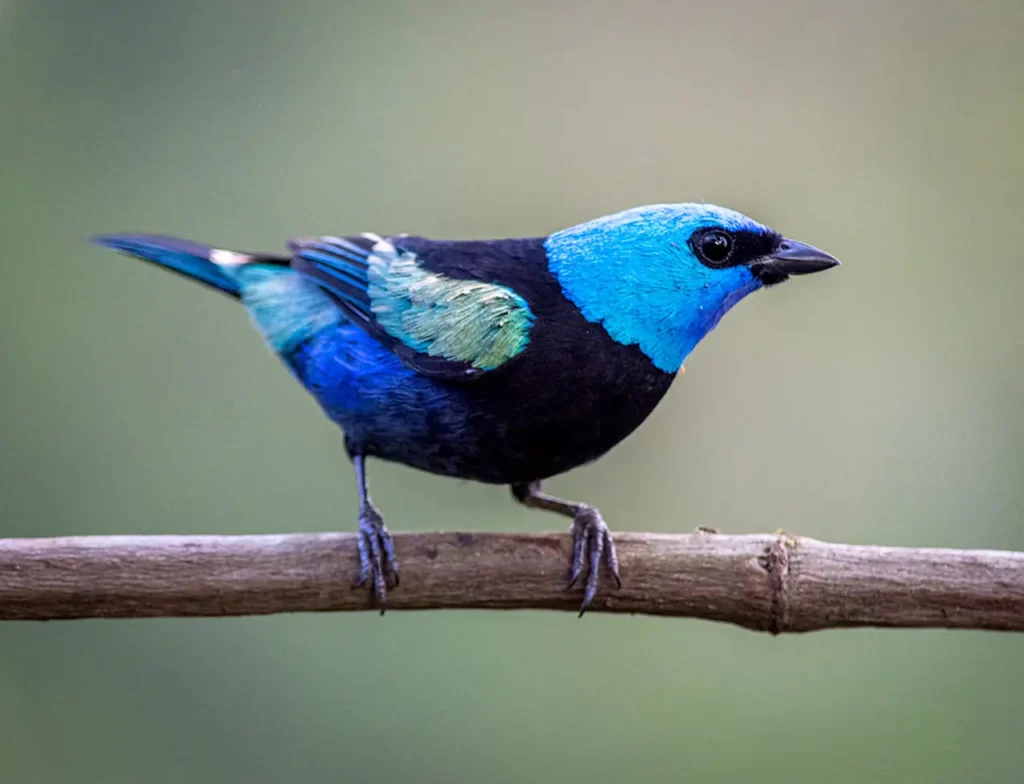
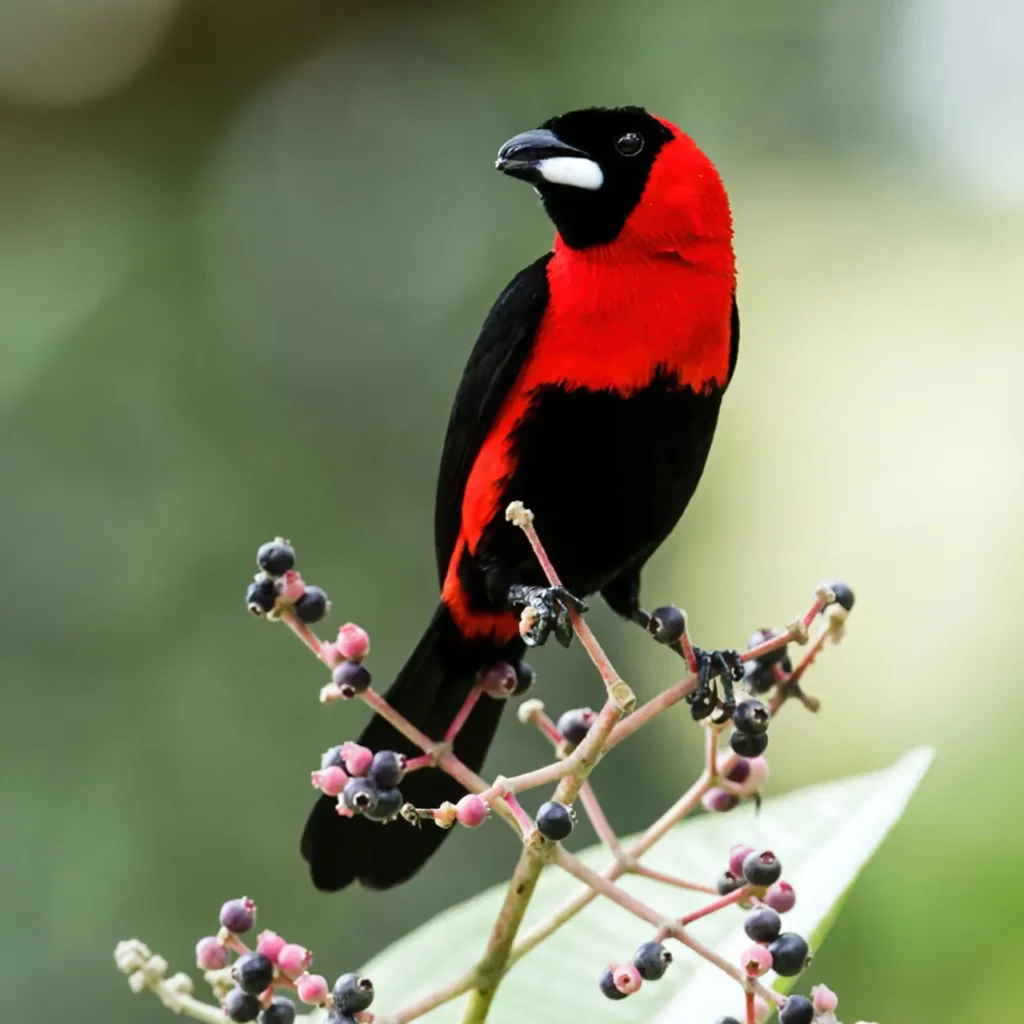
Types of Tanager species
Tanagers are a diverse and colorful group of birds belonging to the family Thraupidae. There are numerous tanager species found across the Americas, from North America to South America. Here are some examples of tanager species:
- Scarlet Tanager (Piranga olivacea): Native to North America, the male Scarlet Tanager has vibrant red plumage, while the female is olive-yellow. They are known for their melodious songs and can be found in deciduous forests during the breeding season.
- Summer Tanager (Piranga rubra): Also found in North America, the male Summer Tanager is bright red, while the female is more yellowish. They primarily feed on insects and can be seen in various habitats, including woodlands and open areas.
- Blue-gray Tanager (Thraupis episcopus): Found in Central and South America, the Blue-gray Tanager is a medium-sized bird with striking blue and gray plumage. They are common in gardens, forests, and urban areas.
- Flame-crested Tanager (Tachyphonus cristatus): Native to South America, the Flame-crested Tanager has a black body with a bright red crest. They are often found in the understory of forests and are known for their loud calls.
- Green-headed Tanager (Tangara seledon): Found in South America, the Green-headed Tanager has a bright green head and a blue body. They are often seen in canopy and forest edges.
- Paradise Tanager (Tangara chilensis): Native to South America, the Paradise Tanager is known for its striking multicolored plumage, with shades of green, blue, and red. They inhabit cloud forests and highland areas.
- Golden Tanager (Tangara arthus): Found in South America, the Golden Tanager has bright yellow plumage with black wings and a blue face. They can be found in montane forests.
- Swallow Tanager (Tersina viridis): Native to South America, the Swallow Tanager is a small bird with glossy blue and black plumage. They are often seen in open areas and forest clearings.
- Red-legged Honeycreeper (Cyanerpes cyaneus): Found in Central and South America, the Red-legged Honeycreeper is a colorful bird with blue and black plumage and bright red legs. They feed on nectar and are often seen in forest edges.
- Silver-beaked Tanager (Ramphocelus carbo): Native to South America, the Silver-beaked Tanager has a black body with a silvery-white beak. They can be found in open habitats and forest edges.
- Bay-headed Tanager (Tangara gyrola): Found in South America, the Bay-headed Tanager is known for its striking plumage with a bright bay-colored head, green body, and blue wings. They inhabit montane forests and are often seen in mixed flocks.
- Rufous-winged Tanager (Tangara lavinia): Native to South America, the Rufous-winged Tanager has a bright yellow body with rufous-colored wings and tail. They are commonly found in humid forests.
- Hooded Tanager (Nemosia pileata): Found in Central and South America, the Hooded Tanager has a black head with a white patch and a blue body. They prefer habitats with dense vegetation and can be seen in forest canopies.
- Flame-faced Tanager (Tangara parzudakii): Native to South America, the Flame-faced Tanager has a bright orange-red face and a blue body. They inhabit cloud forests and are known for their vocalizations.
- Blue-capped Tanager (Sporathraupis cyanocephala): Found in the Andean region of South America, the Blue-capped Tanager has a blue cap, a black body, and a white belly. They are often seen in montane forests.
- Gilt-edged Tanager (Tangara cyanoventris): Native to South America, the Gilt-edged Tanager has a green body with bright blue wings and a golden-yellow edge on the belly. They can be found in forests and woodlands.
- Green Honeycreeper (Chlorophanes spiza): Found in Central and South America, the Green Honeycreeper has a vibrant green plumage with a blue crown. They feed on nectar and are often seen in forest canopies.
- Black-faced Dacnis (Dacnis lineata): Native to South America, the Black-faced Dacnis has a black face with a bright blue body. They are commonly found in humid forests.
- Silver-throated Tanager (Tangara icterocephala): Found in Central and South America, the Silver-throated Tanager has a yellow body with a silver-colored throat. They inhabit a variety of forested habitats.
- Beryl-spangled Tanager (Tangara nigroviridis): Native to South America, the Beryl-spangled Tanager has a bright green plumage with blue and black markings. They can be found in montane forests and woodlands.
- Blue-necked Tanager (Tangara cyanicollis): Found in South America, the Blue-necked Tanager has a blue neck, black face, and yellow body. They inhabit humid forests and are often seen in canopy areas.
- Yellow-bellied Tanager (Ixothraupis xanthogastra): Native to South America, the Yellow-bellied Tanager has a bright yellow underbelly and a black and blue upper body. They are commonly found in forested habitats.
- Golden-hooded Tanager (Tangara larvata): Found in Central and South America, the Golden-hooded Tanager has a golden-yellow head and a blue body. They are often seen in gardens and forest edges.
- Opal-rumped Tanager (Tangara velia): Native to South America, the Opal-rumped Tanager has an iridescent opal-colored rump and a blue body. They inhabit montane forests and cloud forests.
- Rufous-capped Tanager (Chrysothlypis ruficapilla): Found in Central and South America, the Rufous-capped Tanager has a rufous crown and a yellow body. They are commonly seen in dense vegetation and forest understory.
- Black-capped Tanager (Tangara heinei): Native to South America, the Black-capped Tanager has a black cap and a blue and black body. They can be found in forested habitats, including secondary growth areas.
- Blue Dacnis (Dacnis cayana): Found in Central and South America, the Blue Dacnis has a bright blue plumage with a black mask around the eyes. They prefer open woodlands and gardens.
- White-collared Tanager (Tangara heinei): Native to South America, the White-collared Tanager has a white collar around the neck and a blue body. They are often seen in forest edges and secondary growth areas.
- Yellow-backed Tanager (Hemithraupis flavicollis): Found in Central and South America, the Yellow-backed Tanager has a bright yellow back and a black face and belly. They inhabit forested habitats and gardens.
- Rufous-throated Tanager (Tangara rufigula): Native to South America, the Rufous-throated Tanager has a rufous throat and breast with a blue and black body. They are commonly found in montane forests.
- Flame-rumped Tanager (Ramphocelus flammigerus): Found in Central and South America, the Flame-rumped Tanager has a red-orange rump, a black body, and a blue crown. They are often seen in open areas and forest edges.
- Black-and-yellow Tanager (Chrysothlypis chrysomelas): Native to South America, the Black-and-yellow Tanager has a black face and a bright yellow body. They can be found in forested habitats and gardens.
- White-shouldered Tanager (Tachyphonus luctuosus): Found in Central and South America, the White-shouldered Tanager has a black body with white shoulder patches and a red eye-ring. They inhabit forests and woodlands.
- Rufous-winged Tanager (Thlypopsis ruficeps): Native to South America, the Rufous-winged Tanager has a rufous-colored head and wings, with a yellow underbelly. They are commonly found in shrubby habitats.
- Blue-browed Tanager (Thraupis episcopus): Found in South America, the Blue-browed Tanager has a blue forehead and a green body. They are often seen in a wide range of habitats, including forests and gardens.
- Turquoise Tanager (Tangara mexicana): Native to Central and South America, the Turquoise Tanager has a bright turquoise-blue plumage with black wings. They are often found in humid forests.
- Yellow-bellied Dacnis (Dacnis flaviventer): Found in Central and South America, the Yellow-bellied Dacnis has a yellow underbelly and a bright blue upper body. They inhabit forest edges and gardens.
- Black-goggled Tanager (Trichothraupis melanops): Native to South America, the Black-goggled Tanager has a black face with a white patch around the eyes and a blue and black body. They prefer forested habitats.
- Flame-colored Tanager (Piranga bidentata): Found in Central and South America, the Flame-colored Tanager has a bright red-orange plumage. They can be seen in open woodlands and forest edges.
- Spotted Tanager (Tangara punctata): Native to South America, the Spotted Tanager has a blue and black plumage with white spots on the wings. They inhabit forested areas, including cloud forests.
- Flame-capped Tanager (Tachyphonus cristatus): Found in South America, the Flame-capped Tanager has a red-orange crown, black body, and red underparts. They inhabit a variety of forested habitats.
- Black-chested Mountain-Tanager (Cnemathraupis eximia): Native to the Andean region of South America, this tanager species has a black chest, blue head, and green body. They are often seen in montane forests.
- Azure-shouldered Tanager (Tangara cyanoptera): Found in South America, the Azure-shouldered Tanager has a blue crown and shoulder, black face, and green body. They prefer forested habitats, especially along streams.
- Sayaca Tanager (Thraupis sayaca): Native to South America, the Sayaca Tanager has a blue head, neck, and wings, with a black mask and white underparts. They are often seen in open areas and gardens.
- Spangle-cheeked Tanager (Tangara dowii): Found in Central America, the Spangle-cheeked Tanager has a blue and black plumage with iridescent green cheeks. They inhabit forested areas, including cloud forests.
- Golden-naped Tanager (Tangara ruficervix): Native to South America, the Golden-naped Tanager has a golden-yellow nape and a blue and black body. They are often found in montane forests and shrublands.
- Yellow-shouldered Grosbeak (Parkerthraustes humeralis): Found in South America, this tanager has a bright yellow shoulder, black body, and red underparts. They inhabit forests and woodlands.
- Grass-green Tanager (Chlorornis riefferii): Native to South America, the Grass-green Tanager has a bright green plumage with a yellow belly. They prefer montane forests and cloud forests.
- Silver-backed Tanager (Tangara viridicollis): Found in South America, the Silver-backed Tanager has a green back, black face, and blue underparts. They are often seen in forested habitats.
- White-capped Tanager (Sericossypha albocristata): Native to the Andean region of South America, this tanager species has a white cap, black body, and blue wings. They inhabit montane forests.
- Black-headed Hemispingus (Kleinothraupis atropileus): Found in the Andean region of South America, the Black-headed Hemispingus has a black head, gray body, and yellow belly. They are often seen in montane forests and shrubby areas.
- Hooded Mountain-Tanager (Buthraupis montana): Native to the Andean region of South America, this tanager species has a black hood, blue and green body, and white undertail coverts. They inhabit montane forests and cloud forests.
- Silver-throated Mountain-Tanager (Anisognathus subalaris): Found in the Andean region of South America, the Silver-throated Mountain-Tanager has a blue and black plumage with a silver throat. They prefer montane forests and humid habitats.
- Black-chinned Mountain-Tanager (Anisognathus notabilis): Native to the Andean region of South America, this tanager species has a black chin, blue and black body, and a silver throat patch. They are often seen in montane forests.
- Gray-hooded Bush Tanager (Cnemoscopus rubrirostris): Found in South America, the Gray-hooded Bush Tanager has a gray head, black face, and red bill. They prefer dense vegetation in forested habitats.
- White-eared Conebill (Conirostrum leucogenys): Native to South America, the White-eared Conebill has a white ear patch, gray body, and red bill. They are commonly seen in shrubby areas and woodlands.
- Black-goggled Tanager (Trichothraupis melanops): Found in South America, the Black-goggled Tanager has a black face with a white patch around the eyes and a blue and black body. They prefer forested habitats.
- Beryl-spangled Tanager (Tangara nigroviridis): Native to South America, the Beryl-spangled Tanager has a bright green plumage with blue and black markings. They can be found in montane forests and woodlands.
- Fawn-breasted Tanager (Pipraeidea melanonota): Found in South America, the Fawn-breasted Tanager has a fawn-colored breast, blue and black body, and a red bill. They inhabit forested habitats.
- White-lined Tanager (Tachyphonus rufus): Native to South America, the White-lined Tanager has a black body with white wing and tail linings. They are commonly seen in forest edges and secondary growth areas.
- Orange-eared Tanager (Chlorochrysa calliparaea): Found in South America, the Orange-eared Tanager has a bright orange ear patch, green body, and a yellow underbelly. They inhabit montane forests and cloud forests.
- Golden-eared Tanager (Tangara chrysotis): Native to South America, the Golden-eared Tanager has a golden-yellow ear patch, black body, and blue wings. They prefer humid forests and are often seen in the canopy.
- Orange-crowned Euphonia (Euphonia saturata): Found in Central and South America, the Orange-crowned Euphonia has a bright orange crown, blue body, and yellow underparts. They inhabit forested areas and gardens.
- Turquoise Tanager (Tangara mexicana): Native to Central and South America, the Turquoise Tanager has a bright turquoise-blue plumage with black wings. They are often found in humid forests.
- White-banded Tanager (Neothraupis fasciata): Found in South America, the White-banded Tanager has a white band across the chest, black head, and blue and black body. They inhabit montane forests.
- White-winged Shrike-Tanager (Lanio versicolor): Native to South America, the White-winged Shrike-Tanager has a white wing patch, gray body, and black mask. They are often seen in savannas and woodland edges.
- Golden Tanager (Tangara arthus): Found in South America, the Golden Tanager has bright yellow plumage with black wings and a blue face. They can be found in montane forests.
- Gray-headed Tanager (Eucometis penicillata): Native to South America, the Gray-headed Tanager has a gray head, blue body, and yellow underparts. They are often seen in forest edges and gardens.
- Black-faced Dacnis (Dacnis lineata): Found in Central and South America, the Black-faced Dacnis has a black face with a bright blue body. They prefer humid forests and are often seen in the canopy.
- Black-capped Tanager (Tangara heinei): Native to South America, the Black-capped Tanager has a black cap and a blue and black body. They can be found in forested habitats, including secondary growth areas.
- Azure-rumped Tanager (Tangara cabanisi): Found in Central and South America, the Azure-rumped Tanager has a bright blue rump and tail, black head, and blue and black body. They prefer forested habitats, including montane forests.
- Blue-naped Chlorophonia (Chlorophonia cyanea): Native to South America, the Blue-naped Chlorophonia has a blue nape and upper body, with a bright yellow underbelly. They are often seen in forest canopies.
- Golden-eared Hemispingus (Sphenopsis chrysoptera): Found in South America, the Golden-eared Hemispingus has a golden-yellow ear patch, black and gray body, and yellow underparts. They inhabit montane forests.
- Yellow-bellied Tanager (Tangara xanthogastra): Native to South America, the Yellow-bellied Tanager has a bright yellow underbelly, black and blue body, and a red eye-ring. They are commonly found in forested habitats.
- Blue-winged Mountain-Tanager (Anisognathus somptuosus): Found in the Andean region of South America, this tanager species has a blue crown, black body, and blue wings. They inhabit montane forests and cloud forests.
- Gray-and-gold Tanager (Tangara palmeri): Native to South America, the Gray-and-gold Tanager has a gray head and upper body, with a golden-yellow underbelly. They are often seen in forest canopies.
- Yellow-collared Tanager (Iridosornis jelskii): Found in South America, the Yellow-collared Tanager has a yellow collar, black head, and blue and black body. They prefer montane forests and cloud forests.
- Hooded Mountain-Tanager (Buthraupis montana): Native to the Andean region of South America, this tanager species has a black hood, blue and green body, and white undertail coverts. They inhabit montane forests and cloud forests.
- Golden-naped Tanager (Tangara ruficervix): Found in South America, the Golden-naped Tanager has a golden-yellow nape and a blue and black body. They are often found in montane forests and shrublands.
- White-capped Tanager (Sericossypha albocristata): Native to the Andean region of South America, this tanager species has a white cap, black body, and blue wings. They inhabit montane forests.
- Capped Conebill (Conirostrum albifrons): Found in South America, the Capped Conebill has a black cap, gray body, and a red bill. They prefer forested habitats and are often seen in small flocks.
- White-lored Euphonia (Euphonia chrysopasta): Native to Central and South America, the White-lored Euphonia has a bright yellow plumage with a white forehead patch. They inhabit forested areas and gardens.
- Magpie Tanager (Cissopis leverianus): Found in South America, the Magpie Tanager has black and white plumage with a red eye. They are often seen in forest edges and secondary growth areas.
- Saffron-crowned Tanager (Tangara xanthocephala): Native to South America, the Saffron-crowned Tanager has a saffron-colored crown and a blue and black body. They prefer forested habitats.
- Golden-collared Honeycreeper (Iridophanes pulcherrimus): Found in South America, the Golden-collared Honeycreeper has a golden collar and a green and black body. They inhabit forest canopies.
- Golden-crowned Tanager (Iridosornis rufivertex): Native to South America, the Golden-crowned Tanager has a golden crown, black body, and blue wings. They are often seen in montane forests.
- Fawn-breasted Mountain-Tanager (Pseudosaltator rufiventris): Found in the Andean region of South America, this tanager species has a fawn-colored breast, black head, and blue body. They prefer montane forests.
- Black-capped Hemispingus (Kleinothraupis atropileus): Native to South America, the Black-capped Hemispingus has a black cap, gray body, and yellow underbelly. They inhabit montane forests and shrubby areas.
- Grass-green Tanager (Chlorornis riefferii): Found in South America, the Grass-green Tanager has a bright green plumage with a yellow belly. They prefer montane forests and cloud forests.
- Common Bush Tanager (Chlorospingus flavopectus): Native to Central and South America, the Common Bush Tanager has a black cap, olive-green body, and a bright yellow underbelly. They are often seen in forested habitats.
- Yellow-crowned Euphonia (Euphonia luteicapilla): Found in Central and South America, the Yellow-crowned Euphonia has a bright yellow crown, black body, and blue wing edges. They inhabit forested areas and gardens.
- Blue-naped Chlorophonia (Chlorophonia cyanea): Native to South America, the Blue-naped Chlorophonia has a blue nape and upper body, with a bright yellow underbelly. They are often seen in forest canopies.
- Grass-green Tanager (Chlorornis riefferii): Found in South America, the Grass-green Tanager has a bright green plumage with a yellow belly. They prefer montane forests and cloud forests.
- Lemon-rumped Tanager (Ramphocelus icteronotus): Found in Central and South America, the Lemon-rumped Tanager has a lemon-yellow rump, black body, and red underparts. They are often seen in forest edges and clearings.
- Rufous-browed Hemispingus (Poospiza rufosuperciliaris): Native to South America, the Rufous-browed Hemispingus has a rufous eyebrow and a gray body. They are commonly found in shrubby areas and woodlands.
- Lemon-spectacled Tanager (Tangara flavoviridis): Found in South America, the Lemon-spectacled Tanager has a bright yellow eyering and a blue and black body. They prefer forested habitats.
- Golden Grosbeak (Pheucticus chrysogaster): Native to South America, the Golden Grosbeak has a bright yellow underbelly and a black and gray body. They are often seen in forest edges and open areas.
- Red-billed Pied Tanager (Lamprospiza melanoleuca): Found in South America, the Red-billed Pied Tanager has a red bill, black face, and a white and black body. They prefer forested habitats.
- Black-chested Fruiteater (Pipreola lubomirskii): Native to South America, the Black-chested Fruiteater has a black chest and belly with a green back. They are commonly found in montane forests
- Masked Crimson Tanager (Ramphocelus nigrogularis): Found in Central and South America, the Masked Crimson Tanager has a bright red plumage with a black mask across the face. They are often seen in forest edges and gardens.
- Scrub Tanager (Tangara vitriolina): Native to Central and South America, the Scrub Tanager has a bright blue and black plumage. They prefer dry forests and scrublands.
- Golden-crowned Warbler (Basileuterus culicivorus): Found in Central and South America, the Golden-crowned Warbler has a bright yellow crown and a greenish body. They are often seen in forest understory.
- Gray-hooded Bush Tanager (Cnemoscopus rubrirostris): Native to South America, the Gray-hooded Bush Tanager has a gray head, black face, and red bill. They prefer dense vegetation in forested habitats.
- Black-backed Bush Tanager (Urothraupis stolzmanni): Found in the Andean region of South America, this tanager species has a black back, yellow underbelly, and blue wings. They inhabit montane forests.
- Black-eared Hemispingus (Sphenopsis melanotis): Native to South America, the Black-eared Hemispingus has a black ear patch, gray body, and yellow underparts. They inhabit montane forests and shrubby areas.
- Black-bellied Tanager (Ramphocelus melanogaster): Found in Central and South America, the Black-bellied Tanager has a black belly, blue body, and red rump. They are often seen in forest edges and clearings.
- Pileated Finch (Coryphospingus pileatus): Native to South America, the Pileated Finch has a red crown, black body, and white underparts. They are commonly found in forest edges and gardens.
- Beryl-spangled Tanager (Tangara nigroviridis): Found in South America, the Beryl-spangled Tanager has a bright green plumage with blue and black markings. They can be found in montane forests and woodlands.
- Turquoise Tanager (Tangara mexicana): Native to Central and South America, the Turquoise Tanager has a bright turquoise-blue plumage with black wings. They are often found in humid forests.
- Guira Tanager (Hemithraupis guira): Found in South America, the Guira Tanager has a bright yellow plumage with a black face mask. They prefer forested habitats, including secondary growth areas.
- Dotted Tanager (Tangara varia): Native to South America, the Dotted Tanager has a blue and black plumage with white dots on the wings. They are commonly seen in forested areas.
- Black-and-white Tanager (Conothraupis speculigera): Found in South America, the Black-and-white Tanager has a black and white plumage with a bright red rump. They prefer montane forests.
- Pileated Tanager (Lipaugus pileatus): Native to South America, the Pileated Tanager has a black and white plumage with a red crest. They are often seen in forested areas.
- Blue-capped Tanager (Sericossypha albocristata): Found in South America, the Blue-capped Tanager has a blue cap, black body, and blue wings. They inhabit montane forests.
- Red-billed Pied Tanager (Lamprospiza melanoleuca): Native to South America, the Red-billed Pied Tanager has a red bill, black face, and a white and black body. They prefer forested habitats.
- Blue-winged Tanager (Thraupis bonariensis): Found in Central and South America, the Blue-winged Tanager has a blue body and black face. They are commonly seen in open areas and forest edges.
- White-winged Shrike-Tanager (Lanio versicolor): Native to South America, the White-winged Shrike-Tanager has a white wing patch, gray body, and black mask. They are often seen in savannas and woodland edges.
- Black-goggled Tanager (Trichothraupis melanops): Found in South America, the Black-goggled Tanager has a black face with a white patch around the eyes and a blue and black body. They prefer forested habitats.
- Lemon-spectacled Tanager (Tangara flavoviridis): Native to South America, the Lemon-spectacled Tanager has a bright yellow eyering and a blue and black body. They prefer forested habitats.
- Yellow-crowned Tanager (Tachyphonus rufiventer): Found in South America, the Yellow-crowned Tanager has a yellow crown, black body, and blue wings. They prefer forested habitats, including secondary growth areas.
- Green-headed Tanager (Tangara seledon): Native to South America, the Green-headed Tanager has a bright green head, black body, and blue wings. They are commonly found in forested areas.
- Gray-headed Tanager (Eucometis penicillata): Found in South America, the Gray-headed Tanager has a gray head, blue body, and yellow underparts. They prefer forested habitats and are often seen in the canopy.
- White-shouldered Tanager (Tachyphonus luctuosus): Native to Central and South America, the White-shouldered Tanager has a black body with white shoulder patches and a red eye-ring. They inhabit forests and woodlands.
- Black-capped Tanager (Tangara heinei): Found in South America, the Black-capped Tanager has a black cap and a blue and black body. They can be found in forested habitats, including secondary growth areas.
- Dusky-faced Tanager (Mitrospingus cassinii): Native to South America, the Dusky-faced Tanager has a grayish face, black body, and red rump. They are often seen in forested areas.
- White-shouldered Tanager (Tachyphonus luctuosus): Found in Central and South America, the White-shouldered Tanager has a black body with white shoulder patches and a red eye-ring. They inhabit forests and woodlands.
- Black-capped Tanager (Tangara heinei): Native to South America, the Black-capped Tanager has a black cap and a blue and black body. They can be found in forested habitats, including secondary growth areas.
- Rufous-winged Tanager (Tangara lavinia): Found in South America, the Rufous-winged Tanager has a bright yellow body with rufous-colored wings and tail. They are commonly found in humid forests.
- White-lined Tanager (Tachyphonus rufus): Native to South America, the White-lined Tanager has a black body with white wing and tail linings. They are often seen in forest edges and secondary growth areas.
- Green Honeycreeper (Chlorophanes spiza): Found in Central and South America, the Green Honeycreeper has a bright green plumage with a blue crown. They prefer forested habitats and are often seen feeding on nectar.
- White-shouldered Tanager (Lamprospiza melanoleuca): Native to South America, the White-shouldered Tanager has a black face, white shoulder patches, and a black and white body. They are often seen in forested areas.
- White-throated Shrike-Tanager (Lanio leucothorax): Found in South America, the White-throated Shrike-Tanager has a white throat and breast, black mask, and gray body. They prefer open woodlands and savannas.
- Blue-naped Chlorophonia (Chlorophonia cyanea): Native to South America, the Blue-naped Chlorophonia has a blue nape and upper body, with a bright yellow underbelly. They are often seen in forest canopies.
- Yellow-crested Tanager (Tachyphonus rufiventer): Found in South America, the Yellow-crested Tanager has a yellow crest, black body, and blue wings. They prefer forested habitats and are often seen in the canopy.
- Spotted Tanager (Ixothraupis punctata): Native to South America, the Spotted Tanager has a blue and black plumage with white spots on the wings. They inhabit forested areas, including cloud forests.
- Blue-gray Tanager (Thraupis episcopus): Found in Central and South America, the Blue-gray Tanager has a blue-gray plumage with a white throat. They are commonly seen in a wide range of habitats, including forests and gardens.
- Black-faced Dacnis (Dacnis lineata): Native to Central and South America, the Black-faced Dacnis has a black face with a bright blue body. They prefer humid forests and are often seen in the canopy.
- Crested Oropendola (Psarocolius decumanus): Native to Central and South America, the Crested Oropendola has a black body with a bright yellow crest and tail. They are often seen in forested areas and open woodlands.
- Fulvous Shrike-Tanager (Lanio fulvus): Found in South America, the Fulvous Shrike-Tanager has a fulvous-colored body with a black mask. They prefer forested habitats and are often seen in the canopy.
- Bay-headed Tanager (Tangara gyrola): Native to Central and South America, the Bay-headed Tanager has a bright bay-colored head, black body, and blue wings. They are commonly found in forested areas.
- White-banded Tanager (Neothraupis fasciata): Found in South America, the White-banded Tanager has a white band across the chest, black head, and blue and black body. They inhabit montane forests.
- Dusky-faced Tanager (Mitrospingus cassinii): Native to South America, the Dusky-faced Tanager has a grayish face, black body, and red rump. They are often seen in forested areas.
- Silver-beaked Tanager (Ramphocelus carbo): Found in Central and South America, the Silver-beaked Tanager has a black body with a silver-gray bill. They prefer forested habitats and are often seen in the canopy.
- Scarlet-browed Tanager (Heterospingus xanthopygius): Native to South America, the Scarlet-browed Tanager has a bright red crown, black body, and yellow underparts. They are commonly found in forest edges.
- White-throated Tanager (Tangara albicollis): Found in South America, the White-throated Tanager has a white throat and underparts, black face, and blue and black body. They prefer forested habitats.
- Red-hooded Tanager (Piranga rubriceps): Native to Central and South America, the Red-hooded Tanager has a bright red head and underparts, with a black back. They are often seen in forested areas.
- Chestnut-bellied Mountain-Tanager (Dubusia castaneoventris): Found in the Andean region of South America, this tanager species has a chestnut belly and a blue and black body. They inhabit montane forests.
- Blue-winged Mountain-Tanager (Anisognathus somptuosus): Native to the Andean region of South America, this tanager species has a blue crown, black body, and blue wings. They inhabit montane forests and cloud forests.
- Blue-necked Tanager (Tangara cyanicollis): Found in South America, the Blue-necked Tanager has a bright blue neck, black body, and blue wings. They prefer forested habitats, including secondary growth areas.
- Purple Honeycreeper (Cyanerpes caeruleus): Native to Central and South America, the Purple Honeycreeper has a bright purple plumage with a black mask. They are often seen in forest canopies and gardens.
- Yellow-backed Tanager (Hemithraupis flavicollis): Found in South America, the Yellow-backed Tanager has a yellow back, black mask, and gray body. They inhabit forested areas and gardens.
- Flame-faced Tanager (Tangara parzudakii): Native to South America, the Flame-faced Tanager has a bright red face, black body, and blue wings. They prefer forested habitats, including montane forests.
- Black-throated Shrike-Tanager (Lanio aurantius): Found in Central and South America, the Black-throated Shrike-Tanager has a black throat, orange belly, and black and white body. They are often seen in forest edges and clearings.
- Yellow-tufted Dacnis (Dacnis egregia): Native to South America, the Yellow-tufted Dacnis has a bright blue plumage with a yellow tuft on the forehead. They prefer humid forests and are often seen in the canopy.
- Flame-rumped Tanager (Ramphocelus flammigerus): Found in Central and South America, the Flame-rumped Tanager has a red-orange rump, black body, and blue wings. They are commonly found in forest edges.
- Black-throated Grosbeak (Saltator fuliginosus): Native to South America, the Black-throated Grosbeak has a black throat, gray body, and a heavy bill. They prefer forested habitats and are often seen on the ground.
- Yellow-bellied Tanager (Tangara xanthogastra): Found in South America, the Yellow-bellied Tanager has a bright yellow underbelly, black and blue body, and a red eye-ring. They are commonly found in forested habitats.
- Bicolored Conebill (Conirostrum bicolor): Native to South America, the Bicolored Conebill has a black and white plumage with a red bill. They are often seen in montane forests and shrubby areas.
- Black-capped Donacobius (Donacobius atricapilla): Found in Central and South America, the Black-capped Donacobius has a black cap and face with a gray body. They prefer wetland habitats and are often seen near water.
- Gray-headed Tanager (Eucometis penicillata): Native to South America, the Gray-headed Tanager has a gray head, blue body, and yellow underparts. They prefer forested habitats and are often seen in the canopy.
- Yellow-backed Tanager (Hemithraupis flavicollis): Found in South America, the Yellow-backed Tanager has a yellow back, black mask, and gray body. They inhabit forested areas and gardens.
- Flame-faced Tanager (Tangara parzudakii): Native to South America, the Flame-faced Tanager has a bright red face, black body, and blue wings. They prefer forested habitats, including montane forests.
- Black-throated Shrike-Tanager (Lanio aurantius): Found in Central and South America, the Black-throated Shrike-Tanager has a black throat, orange belly, and black and white body. They are often seen in forest edges and clearings.
- Yellow-tufted Dacnis (Dacnis egregia): Native to South America, the Yellow-tufted Dacnis has a bright blue plumage with a yellow tuft on the forehead. They prefer humid forests and are often seen in the canopy.
- Flame-rumped Tanager (Ramphocelus flammigerus): Found in Central and South America, the Flame-rumped Tanager has a red-orange rump, black body, and blue wings. They are commonly found in forest edges.
- Black-throated Grosbeak (Saltator fuliginosus): Native to South America, the Black-throated Grosbeak has a black throat, gray body, and a heavy bill. They prefer forested habitats and are often seen on the ground.
- Yellow-bellied Tanager (Tangara xanthogastra): Found in South America, the Yellow-bellied Tanager has a bright yellow underbelly, black and blue body, and a red eye-ring. They are commonly found in forested habitats.
- Bicolored Conebill (Conirostrum bicolor): Native to South America, the Bicolored Conebill has a black and white plumage with a red bill. They are often seen in montane forests and shrubby areas.
- White-winged Diuca Finch (Diuca speculifera): Found in South America, the White-winged Diuca Finch has a gray body with white wing patches. They are commonly seen in grasslands and open areas.
- Black-throated Saltator (Saltator atricollis): Native to Central and South America, the Black-throated Saltator has a black throat, gray body, and a heavy bill. They prefer forested habitats and are often seen on the ground.
- Blue-black Grassquit (Volatinia jacarina): Found in Central and South America, the Blue-black Grassquit has a blue-black plumage with white wing patches. They are commonly found in grasslands and open areas.
- Silver-beaked Tanager (Ramphocelus carbo): Native to Central and South America, the Silver-beaked Tanager has a black body with a silver-gray bill. They prefer forested habitats and are often seen in the canopy.
- Swallow Tanager (Tersina viridis): Found in South America, the Swallow Tanager has a bright green plumage and a deeply forked tail. They are commonly found in forested habitats near water.
- Yellow-shouldered Grosbeak (Parkerthraustes humeralis): Found in South America, the Yellow-shouldered Grosbeak has a bright yellow shoulder patch, black body, and a heavy bill. They prefer forested habitats and are often seen on the ground.
- Black-backed Tanager (Tangara peruviana): Native to South America, the Black-backed Tanager has a black back and head, with a bright yellow underbelly. They inhabit forested areas, including montane forests.
- Guianan Cock-of-the-rock (Rupicola rupicola): Found in South America, the Guianan Cock-of-the-rock has a bright orange plumage and a distinctive crest. They prefer humid forests and are known for their courtship displays.
- Hooded Tanager (Nemosia pileata): Native to South America, the Hooded Tanager has a black cap and face, with a blue and black body. They are often seen in forested areas, including secondary growth.
- Slaty Tanager (Creurgops dentatus): Found in Central and South America, the Slaty Tanager has a slaty-blue plumage with a black face. They inhabit forested areas and are often seen in small flocks.
- Black-capped Hemispingus (Kleinothraupis atropileus): Native to South America, the Black-capped Hemispingus has a black cap, gray body, and yellow underparts. They inhabit montane forests and shrubby areas.
- Yellow-rumped Tanager (Hemithraupis flavicollis): Found in South America, the Yellow-rumped Tanager has a yellow rump, black mask, and gray body. They prefer forested habitats and are often seen in the canopy.
- Red-crested Finch (Coryphospingus cucullatus): Native to South America, the Red-crested Finch has a red crest, black body, and white underparts. They are commonly found in forest edges and gardens.
- Hepatic Tanager (Piranga flava): Found in Central and South America, the Hepatic Tanager has a bright red plumage with a dark grayish-black back. They prefer forested habitats and are often seen in the canopy.
- Golden-eared Tanager (Tangara chrysotis): Native to South America, the Golden-eared Tanager has a golden-yellow ear patch, black and gray body, and yellow underparts. They inhabit montane forests.
- White-winged Shrike-Tanager (Lanio versicolor): Found in South America, the White-winged Shrike-Tanager has a white wing patch, gray body, and black mask. They are often seen in savannas and woodland edges.
- Ashy-throated Bush Tanager (Chlorospingus canigularis): Native to South America, the Ashy-throated Bush Tanager has an ashy-gray throat and underparts, black cap, and greenish back. They prefer forested areas and are often seen in small flocks.
- Silver-backed Tanager (Tangara viridicollis): Found in South America, the Silver-backed Tanager has a black head, bright yellow underbelly, and silver-blue back. They are commonly found in forested habitats.
- Red-crowned Ant-Tanager (Habia rubica): Native to Central and South America, the Red-crowned Ant-Tanager has a bright red crown, black face, and white underparts. They are often seen in forested areas, including edges and clearings.
- Lemon-spectacled Tanager (Tangara flavoviridis): Found in South America, the Lemon-spectacled Tanager has a bright yellow eyering and a blue and black body. They prefer forested habitats.
- Black-capped Antwren (Herpsilochmus atricapillus): Found in South America, the Black-capped Antwren has a black cap, white face, and gray body. They prefer forested habitats, including understory and dense vegetation.
- Saffron Finch (Sicalis flaveola): Native to South America, the Saffron Finch has a bright yellow plumage with an orange face. They are commonly found in open grasslands, gardens, and agricultural areas.
- Gray-hooded Attila (Attila rufus): Found in Central and South America, the Gray-hooded Attila has a gray head, black body, and a white wing patch. They inhabit forested areas, including edges and clearings.
- Swallow Tanager (Tersina viridis): Native to South America, the Swallow Tanager has a bright green plumage and a deeply forked tail. They are commonly found in forested habitats near water.
- Green-throated Mango (Anthracothorax viridigula): Found in Central and South America, the Green-throated Mango is a species of hummingbird with a vibrant green throat and plumage. They are commonly found in gardens and forest edges.
- White-lined Tanager (Tachyphonus rufus): Native to South America, the White-lined Tanager has a black body with white wing and tail linings. They are often seen in forest edges and secondary growth areas.
- Magpie Tanager (Cissopis leverianus): Found in South America, the Magpie Tanager has black and white plumage with a red eye. They are often seen in forest edges and secondary growth areas.
- Spotted Tanager (Ixothraupis punctata): Native to South America, the Spotted Tanager has a blue and black plumage with white spots on the wings. They inhabit forested areas, including cloud forests.
- Scarlet-browed Tanager (Heterospingus xanthopygius): Found in South America, the Scarlet-browed Tanager has a bright red crown, black body, and yellow underparts. They are commonly found in forest edges.
- Ultramarine Grosbeak (Cyanoloxia brissonii): Native to South America, the Ultramarine Grosbeak has a bright blue plumage with a black face and bib. They prefer forested areas and are often seen on the ground.
- White-banded Tanager (Neothraupis fasciata): Found in South America, the White-banded Tanager has a white band across the chest, black head, and blue and black body. They inhabit montane forests.
- Black-cowled Saltator (Saltator nigriceps): Native to South America, the Black-cowled Saltator has a black cap and face, gray body, and a heavy bill. They prefer forested habitats and are often seen on the ground.
- Masked Tanager (Tangara nigrocincta): Found in South America, the Masked Tanager has a black mask and a blue and black body. They are often seen in forested areas, including secondary growth.
- Gray-headed Tanager (Euscarthmus meloryphus): Native to South America, the Gray-headed Tanager has a gray head, black body, and white wing patches. They inhabit forested areas, including edges and clearings.
- White-lined Tanager (Tachyphonus rufus): Found in South America, the White-lined Tanager has a black body with white wing and tail linings. They are often seen in forest edges and secondary growth areas.
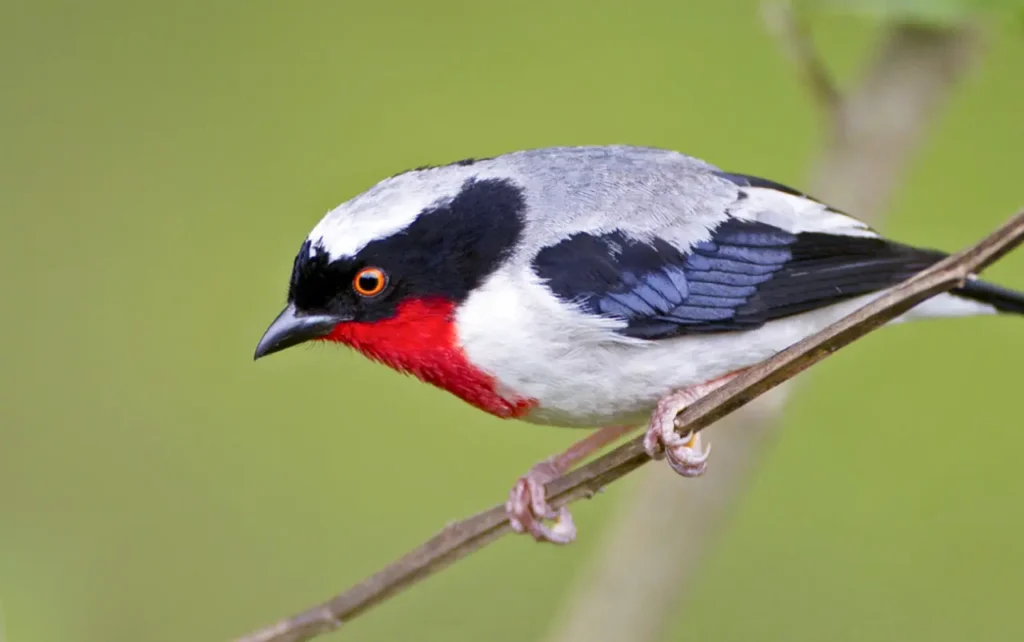
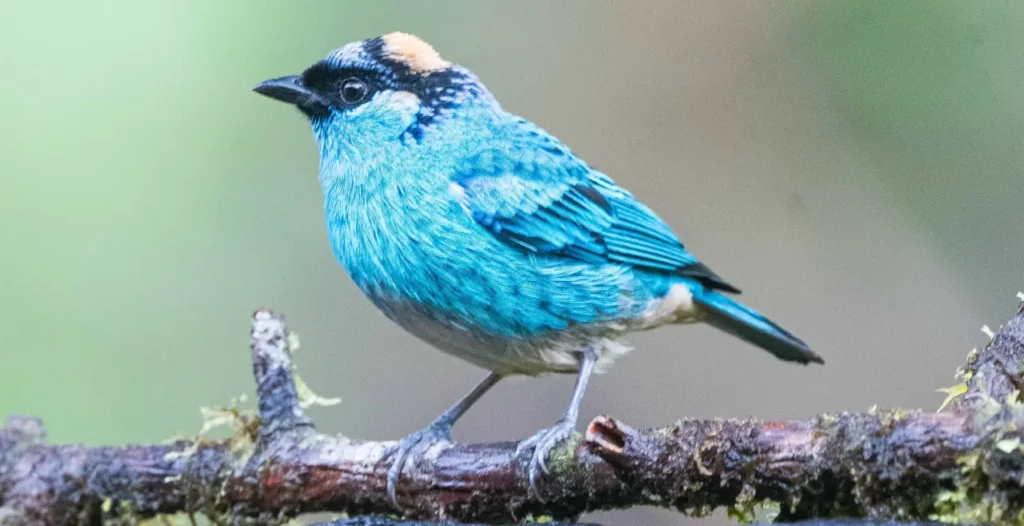
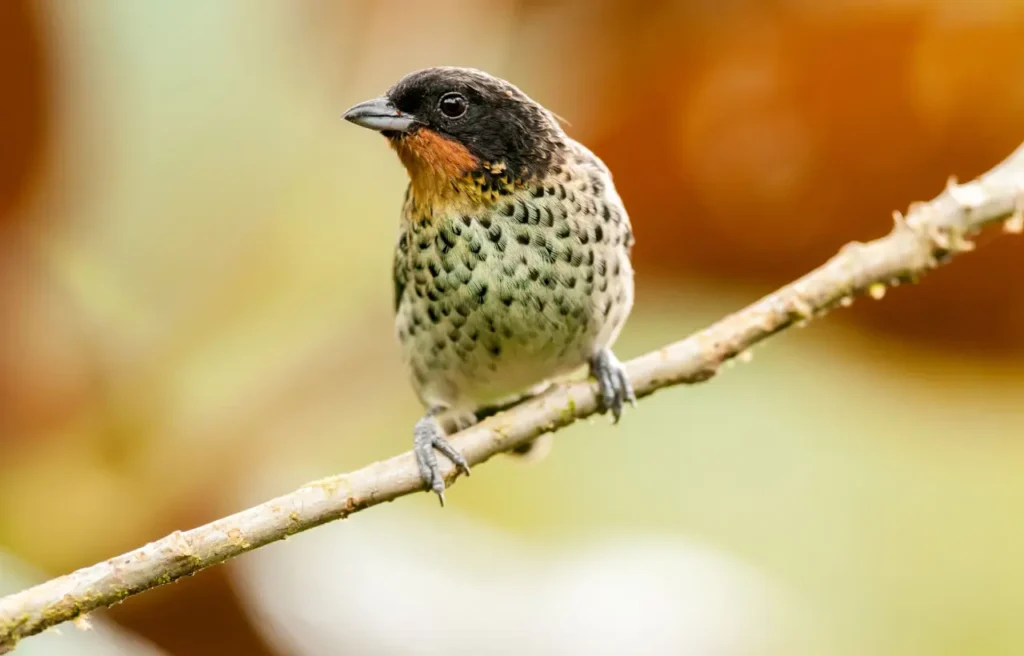
These are just a few examples of the wide variety of tanager species found in the Americas. Each species has its own unique colors, patterns, and behaviors, making them a fascinating and captivating group of birds.
